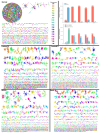Single-Sample Networks Reveal Intra-Cytoband Co-Expression Hotspots in Breast Cancer Subtypes
- PMID: 39596229
- PMCID: PMC11594411
- DOI: 10.3390/ijms252212163
Single-Sample Networks Reveal Intra-Cytoband Co-Expression Hotspots in Breast Cancer Subtypes
Abstract
Breast cancer is a heterogeneous disease comprising various subtypes with distinct molecular characteristics, clinical outcomes, and therapeutic responses. This heterogeneity evidences significant challenges for diagnosis, prognosis, and treatment. Traditional genomic co-expression network analyses often overlook individual-specific interactions critical for personalized medicine. In this study, we employed single-sample gene co-expression network analysis to investigate the structural and functional genomic alterations across breast cancer subtypes (Luminal A, Luminal B, Her2-enriched, and Basal-like) and compared them with normal breast tissue. We utilized RNA-Seq gene expression data to infer gene co-expression networks. The LIONESS algorithm allowed us to construct individual networks for each patient, capturing unique co-expression patterns. We focused on the top 10,000 gene interactions to ensure consistency and robustness in our analysis. Network metrics were calculated to characterize the topological properties of both aggregated and single-sample networks. Our findings reveal significant fragmentation in the co-expression networks of breast cancer subtypes, marked by a change from interchromosomal (TRANS) to intrachromosomal (CIS) interactions. This transition indicates disrupted long-range genomic communication, leading to localized genomic regulation and increased genomic instability. Single-sample analyses confirmed that these patterns are consistent at the individual level, highlighting the molecular heterogeneity of breast cancer. Despite these pronounced alterations, the proportion of CIS interactions did not significantly correlate with patient survival outcomes across subtypes, suggesting limited prognostic value. Furthermore, we identified high-degree genes and critical cytobands specific to each subtype, providing insights into subtype-specific regulatory networks and potential therapeutic targets. These genes play pivotal roles in oncogenic processes and may represent important keys for targeted interventions. The application of single-sample co-expression network analysis proves to be a powerful tool for uncovering individual-specific genomic interactions.
Keywords: breast cancer networks; co-expression networks; intra-chromosomal hotspots; intra-cytoband co-expression; single-sample networks.
Conflict of interest statement
The authors declare no conflicts of interest.
Figures







Similar articles
-
Genomic subtypes of breast cancer identified by array-comparative genomic hybridization display distinct molecular and clinical characteristics.Breast Cancer Res. 2010;12(3):R42. doi: 10.1186/bcr2596. Epub 2010 Jun 24. Breast Cancer Res. 2010. PMID: 20576095 Free PMC article.
-
Competing endogenous RNA network analysis identifies critical genes among the different breast cancer subtypes.Oncotarget. 2017 Feb 7;8(6):10171-10184. doi: 10.18632/oncotarget.14361. Oncotarget. 2017. PMID: 28052038 Free PMC article.
-
Expression and methylation patterns partition luminal-A breast tumors into distinct prognostic subgroups.Breast Cancer Res. 2016 Jul 7;18(1):74. doi: 10.1186/s13058-016-0724-2. Breast Cancer Res. 2016. PMID: 27386846 Free PMC article.
-
Gene-Expression Profiling to Decipher Breast Cancer Inter- and Intratumor Heterogeneity.Cold Spring Harb Perspect Med. 2024 Jan 2;14(1):a041320. doi: 10.1101/cshperspect.a041320. Cold Spring Harb Perspect Med. 2024. PMID: 37137498 Review.
-
The changing role of pathology in breast cancer diagnosis and treatment.Pathobiology. 2011;78(2):99-114. doi: 10.1159/000292644. Epub 2011 Jun 14. Pathobiology. 2011. PMID: 21677473 Free PMC article. Review.
References
-
- Sørlie T., Perou C.M., Tibshirani R., Aas T., Geisler S., Johnsen H., Hastie T., Eisen M.B., van de Rijn M., Jeffrey S.S., et al. Gene expression patterns of breast carcinomas distinguish tumor subclasses with clinical implications. Proc. Natl. Acad. Sci. USA. 2001;98:10869–10874. doi: 10.1073/pnas.191367098. - DOI - PMC - PubMed
-
- Albert R., Barabasi A.L. Statistical mechanics of complex networks. Rev. Mod. Phys. 2002;74:47–97. doi: 10.1103/RevModPhys.74.47. - DOI
MeSH terms
Substances
Grants and funding
LinkOut - more resources
Full Text Sources
Medical
Research Materials
Miscellaneous

